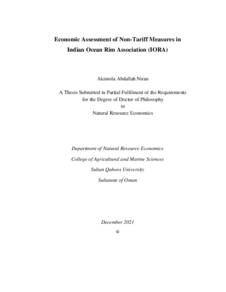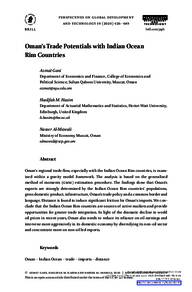وثيقة
Economic assessment of non-tariff measures in Indian Ocean Rim Association (IORA).
الناشر
Sultan Qaboos University.
ميلادي
2021
اللغة
الأنجليزية
الملخص الإنجليزي
The Indian Ocean has always been a trade nexus connecting Asia, the Middle
East and Africa and has recently seen key players in global trade showing great
interest in the region. In the coming decades, economic and productivity growth
is expected to rise considering its relative population, growing market and
strategic location. The Indian Ocean Rim Association (IORA) is a regional
association based on the principle of open regionalism to promote liberalization
through trade and investment facilitation. IORA region has in recent years, just
like the world, witnessed an increase in the prevalence of NTMs and accounts
for about 18% of global NTMs notified to the World Trade Organization (WTO).
The trade cost as a result of NTMs is more than double custom tariffs and would
serve as a hindrance to achieving economic integration and sustainable growth
of the region. Based on this, this thesis assesses the impact of NTMs in IORA
using a combination of descriptive, partial and general equilibrium analysis.
The specific objectives of the thesis are First, analyze trade patterns and assess
the prevalence of NTMs in the region using standard indicators. Secondly,
estimate the advalorem tariff equivalents (AVE) of NTMs as applied to
agricultural and non-agricultural products using a partial equilibrium
framework (gravity model). Thirdly, to evaluate the economy-wide effects of
gradual tariff liberalization in the IORA region using the dynamic general
equilibrium modelling framework. Lastly, to Explore IORA integration
scenarios in which NTM reduction and trade facilitation is the driver of trade
policy reforms.
The descriptive analysis indicates significant diversity in the tariff regime, NTM
and trade facilitation performance. More than half of IORA members still
operate moderate to restrictive tariff regimes and a majority of the members
perform below the global average based on trade facilitation indicators. The
level of intra-trade is high but have been attributed to the overlap of plurilateral
trade agreements in the region.
The partial equilibrium analysis, using gravity model, estimated the importer
specific Ad-valorem equivalents for four (4) mostly used NTMs in the region,
that is sanitary and phytosanitary measures (SPS), technical barriers to trade
(TBT), quantitative restriction (QR) and safeguard measures (SG). The results
showed the presence of both import-impeding and promoting effects of NTMs;
however, the import-impeding effect dominates in the region. The quantitative
restriction and safeguard measures were more restrictive compared to sanitary
and phytosanitary measures and technical trade barriers. This is quite expected
as quantitative restrictions are trade-distorting by design. The results also
indicated that agricultural and food products are negatively affected by NTMs,
mostly quantitative restriction and safeguards measures despite the prevalence
of the SPS measures in the agriculture sector.
The general equilibrium analysis made use of the newly developed recursive
dynamic general equilibrium model, GTAP-RD, to evaluate two main scenarios.
Scenario I evaluate the effect of a gradual tariff cut on IORA while Scenario II
combines the impact of tariff cuts, NTM reduction and trade facilitation. The
scenarios were compared to the present Open regionalism status of IORA.
Results from both scenarios show that the manufacturing sector would be
positively impacted more than the agri-food sectors. It also indicates that middle
and low-income countries in IORA would benefit more than higher-income
countries from deeper integration. The overall results from welfare effects,
GDP, exports, imports, sectoral output and investment accentuate the benefits
that would be derived by IORA countries deciding to go deeper in economic
integration as compared to the present form of open regionalism framework.
This study recommends reforming trade policy in the region toward NTMs that
are more transparent and trade enhancing. It also recommends harmonization
and mutual recognition of standards and measures that would facilitate trade
and investment in the region.
المجموعة
URL المصدر
قالب العنصر
الرسائل والأطروحات الجامعية



